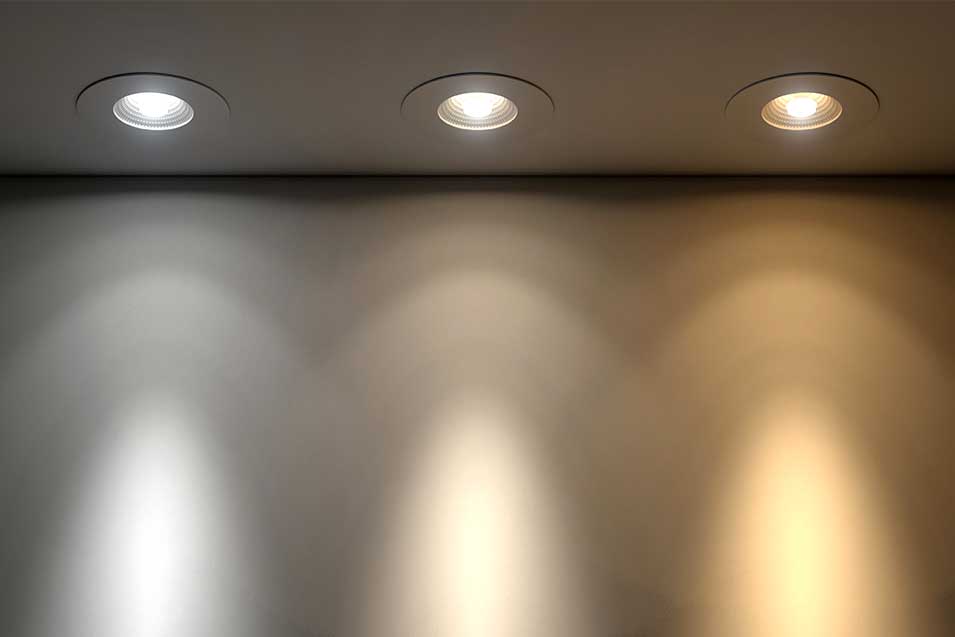
Tips to Choose the Best Colour Light for Your Bedroom
22nd August 2025 | Written By: Vinod Pottayil | Read Time: 3min | Last Updated: 22nd August 2025
A bedroom is perhaps the coziest and most personal space of your home. It is the place where you spend at least 8-10 hours a day—sleeping, reading, spending time with family, or doing other routine activities. It only makes sense that your bedroom has the right illumination for both comfort and aesthetic appeal.
This guide will help you make the right choice for colour lights in your bedroom.
-
Know Colour Temperature Basics
The colour temperature is instrumental in setting up the ambience and mood of your bedroom. Its measurement unit is Kelvin (K). Usually, the colour temperature is divided into three categories based on K:
- Warm White Light (2000K-3000K): It imparts a pleasing character to the space.
- Neutral White Light (3000K-4500K): It provides the impression of daylight, initiating a sense of harmony and natural light in the room.
- Cool White Light (4500K onwards): It injects a cheerful, uplifting look into the space, something akin to sunlight.
The warm white light is considered more appropriate for bedrooms. Given that it inclines towards balance without being too bright or dull, it lends a soft, intimate, and relaxing backdrop to the bedroom. It eases eye strain and helps you put your feet up after an arduous day. Most importantly, it gives a feel of a sunset or candlelight at night, beckoning your body to sleep.
However, you may also opt for neutral light or cool light in the bedroom for a specific corner or artifact where you need better visibility.
-
Use the Right Colours
Blue light from digital devices and green light hinder the production of melatonin, a hormone responsible for sound sleep. So, you should avoid blue and green lights in the bedroom.
Different shades of yellow, red, and orange lights aid in melatonin production and prepare your body and mind to sleep. They are ideally the best colour lights for your bedroom.
-
Match the Light Colours to Paint Colours
The type of lights you choose for the bedroom should complement its colour palette of the walls and ceiling. For example, warm white light bulbs can highlight the earthy tones or peachy pinks of the room well. However, cool white light is more suitable for pastel colours.
It is advisable to do a patch test of the paint at different times of the day to find the right match between the lighting and the paint.
-
Consider Different Types of Lighting
Your bedroom is an extension of your personality. It comprises several interior design elements that serve either a visual or functional purpose. Hence, you can explore different lighting options:
- Task lighting for a reading nook or study unit in the bedroom. Examples: desk lamp, vanity lights
- Accent Lighting for capturing attention towards a painting, wall art, or collectables. Examples: spotlight, floodlight
- Ambient Lighting for uniform brightness. Examples: chandeliers, LED downlights
- Decorative lighting for a warm and inviting vibe. Examples: pendant lights, floor lamps
-
Utilize the Natural Light
Try to create a synchronization between the natural light and artificial light sources for a good lighting effect in the bedroom. If your space gets ample natural light, lighting fixtures will need to operate for a shorter time. This will help curb the energy consumption. Alternatively, if the bedroom receives limited natural light, you can invest in energy-efficient light sources. This way, despite running for a longer period, they will still keep your electricity bill under control.
-
Decide Upon Bulb Types
You can choose from incandescent, halogen, LED, or CFL bulbs—the options are galore. You can either go for uniform lighting or play around with different ones based on their wattage and colour temperatures.
These days, smart bulbs are making quite a wave in home lighting solutions. These bulbs have adjustable brightness and colours that can be synced with your mood and other personal preferences. You can manage these bulbs via a phone app or a voice assistant.
Conclusion
Your bedroom is a haven. It’s only appropriate that it should have well-thought-out light colour temperatures for serenity, appeal, and practicality. Keep the tips mentioned above in mind while making a decision.

Frequently Asked Questions (FAQs) :
- Q1. What colour temperatures should I consider for bedroom lighting? You can choose from warm white, neutral white, and cool white colour temperatures. Each of these falls under Kelvin (K) units to help you understand the light appearance of the light source. Generally, warm white is recommended for the bedroom. However, there is no rulebook to play by.
- Q2. Which light colours should be avoided in the bedroom?
You should avoid installing blue and green lights, as they interfere with your sleep. Orange, red, and yellow shades of light are ideal for the body’s natural sleep-wake cycle. - Q3. Can I use different types of lighting in the bedroom? Absolutely! You can explore several options, from task lighting to accent lighting, ambient lighting, and decorative lighting. You can use them for wardrobes, ceilings, floor lamps, headboards, chandeliers, artefacts, etc.
- Q4. Which light bulbs are the best fit for the bedroom?
Incandescent, CFLs, LEDs, or halogen—each of them has its merits and demerits. However, LEDs are more energy-efficient. They are also available in multipurpose functions, shapes, and sizes. Smart bulbs, which can be manipulated as per their brightness and your mood, are also a good choice for the bedroom. - Q5. Do the paint colour scheme and natural light in the bedroom make a difference to the choice of colour lights?
It is advisable to consider these two aspects for balanced illumination in the bedroom.




